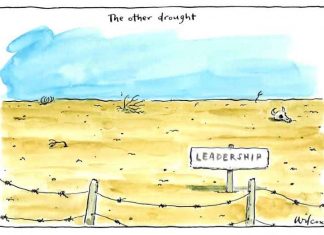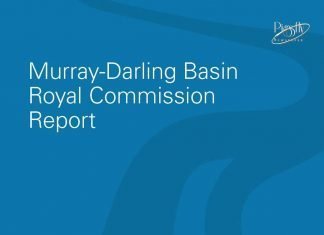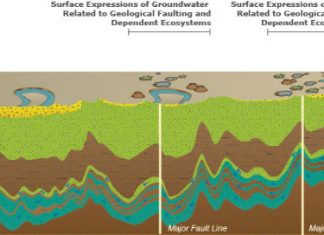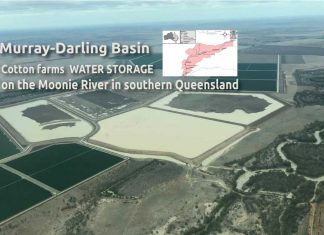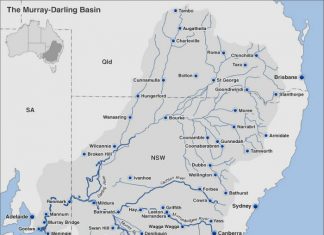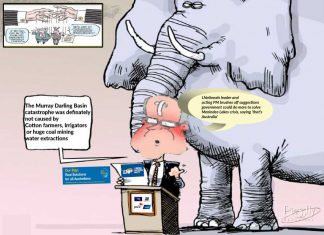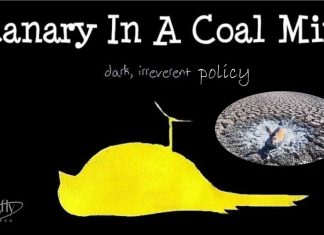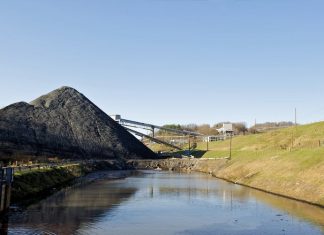New Royal Commission into water theft may be just the tip of iceberg for the Murray Darling Basin
Jamie Pittock, Australian National University
Last weekend South Australian Premier Jay Weatherill announced the establishment of a Royal Commission to investigate breaches of the Murray Darling Basin Agreement.
This follows apparently egregious behaviour by some irrigators and state government regulators in New South Wales. Yet the alleged theft of water in the Murray-Darling Basin is only the tip of the iceberg when we consider the institutional problems – namely the capture of state government agencies by powerful irrigation interests.
Take NSW as an example. In 1993 the then state Department of Water Resources’ North west rivers audit found the same theft, meter-tampering and questionable government oversight exposed again by the ABC’s Four Corners investigation in July.
Only half of the targeted volume of salt has been flushed out to sea and the water supply to Broken Hill and other communities has become unreliable. Moreover, floodplain forests and wetlands of international significance continue to decline, and native fish and water bird populations have flatlined.
In fact, many values are at risk in the river system that supplies water to more than 3 million people, and covers a seventh of Australia’s landmass. It is not only a few (alleged) bad apples, it is governance of water that is broken.
Problems with the existing plan
While bad behaviour in NSW is evident, of more concern is the way some state governments are frustrating implementation of the A$13 billion 2012-26 Basin Plan and associated programs to recover water for the river system.
If the Basin Plan is to improve the health of the river and its extensive floodplain forests along the lower River Murray, the water recovered for the environment needs to be released in pulses. That will be the best way to ensure it can rise out of the river channel and inundate wetlands.
Read more: Is the Murray-Darling Basin Plan broken?
In this context it is unhelpful for the Victorian Government to propose flows of around half the previously agreed size because of the objections of a small number of landowners along the Goulburn River in its Goulburn key focus area project.
Upstream, state governments have rules that allow water purchased by taxpayers for the river to be extracted by irrigators when it crosses state borders. However, they are failing to remove bottlenecks that prevent managed floods from travelling safely down rivers. They have even proposed to reduce the water available for the environment below minimum requirements.
Astonishingly, 30% of water extraction points in the Basin are still not metered and the information that is collected is not publicly available or audited so that theft can be penalised.
Sustainable management required
Sustainable management of the Murray-Darling Basin requires trust and cooperation among the responsible state, ACT and federal governments.
The alleged water theft in NSW breaks that trust, especially for SA as the downstream state that relies on the River Murray. But so too does the stalling of implementation of the Basin Plan agreement and manipulation of the rules that govern who gets what water and when they get it.
Read more: ‘Tax returns for water’: satellite-audited statements can save the Murray-Darling
The foundation of trust is transparency. As a start, there are many opportunities for online recording of water allocations and use to increase trust. It is still possible to fix implementation of the Plan.
In a report released yesterday the Wentworth Group of Concerned Scientists has identified several solutions, including metering all water diversions, completing water recovery, and investing in regional development.
The good news is that there are signs of political leadership. The Council of Australian Governments promised in June to deliver the Basin Plan “in full and on time” for its planned commencement in 2019.
Recently, Prime Minister Malcolm Turnbull recommitted the federal government to Basin Plan implementation. He endorsed the far-reaching recommendations of the Murray-Darling Basin Authority’s Basin-wide Compliance Review to strengthen enforcement of water laws and the Basin Plan, and to recover the remaining environmental water.
The SA Royal Commission
Beginning in 2018, Weatherill’s newly announced Royal Commission will investigate breaches of the Murray Darling Basin Agreement, and the Commissioner “will examine the adequacy of existing legislation and practices and make recommendations for any necessary changes.”
Most significantly, Weatherill has proposed going beyond water theft to “look into whether any legislative or policy changes since the agreement was signed in 2012 have been inconsistent with the purpose of the Basin Agreement and Basin Plan”.
Read more: We need more than just extra water to save the Murray-Darling Basin
The Royal Commission’s terms of reference are not yet available and the extent of cooperation of upstream governments is highly uncertain (NSW has already said it will not cooperate). Yet the Royal Commission could help identify ways to better meter and account for water, improve compliance and set rules to protect environmental water.
At the next Basin Ministerial Council meeting later this year the governments need to map out measures to put the Plan back on track. If it can do so, it will be endorsed at the Council of Australian Governments in 2018. This is their opportunity to articulate precisely how they will fulfil their commitment to delivering the basin plan in full and on time.
![]() The Murray-Darling Basin Plan is not perfect. Implementation has problems, but with the remaining $5.1 billion allocated funds and proper leadership it can be well implemented to benefit both people and the environment.
The Murray-Darling Basin Plan is not perfect. Implementation has problems, but with the remaining $5.1 billion allocated funds and proper leadership it can be well implemented to benefit both people and the environment.
Jamie Pittock, Director, International Programs, UNESCO Chair in Water Economics and Transboundary Water Governance, Australian National University
This article was originally published on The Conversation. Read the original article.
REVIEW OF WATER REFORM IN THE MURRAY-DARLING BASIN
Recommendations: Five actions necessary to deliver the Basin Plan “on time and in full”
COAG should agree to the following five actions to deliver the Murray-Darling Basin Plan ‘on time and in full’. Future payments by the Commonwealth should be contingent on states delivering these actions, with annual audits of progress by COAG.
1. Rebuild trust with greater transparency, by:
- Improving metering and compliance by Commonwealth, state and territory governments agreeing to comprehensive measurement of consumptive water use and water interception, including groundwater, across the whole Basin to a standard suitable for compliance action.
- Improving accountability with professional water accounting standards and independent auditing against standards, accompanied by annual audits of expenditure of public funds and annual reviews of the Basin Plan’s progress by an independent auditor.
- Reinstating a basin-wide river monitoring program to measure and report regularly on the overall condition of the 23 river systems across the Basin as well as targeted programs reporting on progress towards specific Basin Plan objectives against what would have occurred without the Basin Plan.
- Strengthening the capacity of the Murray-Darling Basin Authority to fulfil duties as a regulator.
2. Guarantee recovery of the full 3,200 GL or genuinely equivalent outcomes, by:
- Securing the remaining 1,093 GL or equivalent, including the 450 GL to enhance the Basin’s health, through a combination of strategic water purchase, water efficiency programs and on-farm investment, but only where such recovery results in measurable additional water to the river system. Water recovered must account for the reduction in runoff and groundwater recharge that would have otherwise benefitted the environment.
- Ensuring environmental outcomes are equivalent or better as a result of any adjustment to the sustainable diversion limit by agreeing to the conditions in Table 10 on page 52. Rivers need water, and ‘complementary measures’ such as carp herpes virus, are not a substitute for real water.
- Making sure water recovered for the environment is protected in the river and not being undermined by changes to state water resource plans, river management and operating rules, changes to baselines or model assumptions (as defined in Table 12 on page 59), and other land use changes that affect water availability in the catchments (e.g. farm dams, plantations, floodplain harvesting).7
3. Ensure that water recovered achieves measurable improvements to the river system, by:
- Removing constraints (physical and policy) that restrict the use or passage of environmental water to target floodplains and wetlands, by re-configuring infrastructure and enforcing planning restrictions in designated floodways (see Table 13 on page 62), and where appropriate, compensating for any third party impacts.
- Ensuring sufficient water reaches the Lower Lakes, Coorong and Murray Mouth to export salt from the Basin, reduce water quality risks, and deliver freshwater to maintain the ecological character of the Ramsar wetlands.
- Aligning the Basin Plan targets, the Basin-wide environmental watering strategy, and water resource plans, at the catchment level as part of the accreditation process to achieve outcomes.
4. A regional development package that puts communities at the centre of reform, by:
- Assisting communities most affected by water recovery to restructure their economies to adapt to a future with less water. Assigning for example, 10% of the remaining $5.1 billion would release up to $500 million for regional development initiatives.
- Linking public funding directly to the Basin Plan, by the Commonwealth working directly with community leaders, local government, regional development boards and natural resource management agencies to recover the water in a manner that optimises regional development opportunities for those communities.
5. Prepare for the prospect of a future with less water, by:
- Improving scientific understanding of the potential future stresses caused by extreme weather events (e.g. more frequent and more severe drought and higher evaporation from rising temperature) and long-term changes in climate including water availability, supported by a climate change adaptation program for environmental assets, industries and public infrastructure.
- Expanding the mandate of the Basin Plan to integrate water planning with broader natural resource management to improve the overall environmental condition of the Basin.
- Investing in knowledge and capacity to enhance agricultural productivity, sustainable production and food and water security, and protect the natural resource base in a variable and changing climate.
- Ensuring water reform remains a permanent item on the COAG agenda, and recognising the long-term nature of national water reform via the establishment of an independent expert body to undertake regular reviews of progress.

Improving accountability with professional water accounting standards and independent auditing against standards, accompanied by annual audits of expenditure of public funds and annual reviews of the Basin Plan’s progress by an independent auditor.

Making sure water recovered for the environment is protected in the river and not being undermined by changes to state water resource plans, river management and operating rules, changes to baselines or model assumptions (as defined in Table 12 on page 59), and other land use changes that affect water availability in the catchments (e.g. farm dams, plantations, floodplain harvesting).7

The Great Artesian Basin (GAB[1]), located in Australia, is the largest and deepest artesian basin in the world, stretching over 1,700,000 square kilometres (660,000 sq mi), with measured temperatures ranging from 30–100 °C (86–212 °F). The basin provides the only source of fresh water through much of inland Australia.[2]
The Basin underlies 23% of the continent, including the states and territories of Queensland (most of), the Northern Territory (the south-east corner of), South Australia (the north-east part of), and New South Wales (northern part of). The basin is 3,000 metres (9,800 ft) deep in places and is estimated to contain 64,900 cubic kilometres (15,600 cu mi) of groundwater.[3] The Great Artesian Basin Coordinating Committee (GABCC)[4] coordinates activity between the various levels of government and community organisations.

The Great Artesian Basin (GAB[1]), located in Australia, is the largest and deepest artesian basin in the world, stretching over 1,700,000 square kilometres (660,000 sq mi), with measured temperatures ranging from 30–100 °C (86–212 °F). The basin provides the only source of fresh water through much of inland Australia.[2]
The Basin underlies 23% of the continent, including the states and territories of Queensland (most of), the Northern Territory (the south-east corner of), South Australia (the north-east part of), and New South Wales (northern part of). The basin is 3,000 metres (9,800 ft) deep in places and is estimated to contain 64,900 cubic kilometres (15,600 cu mi) of groundwater.[3] The Great Artesian Basin Coordinating Committee (GABCC)[4] coordinates activity between the various levels of government and community organisations.


